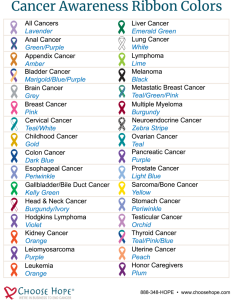The color of the ribbon signifies a specific type of cancer, and understanding the meanings can help promote awareness within communities. In addition, certain months are dedicated to raising awareness about specific types of cancer, emphasizing the need for early detection, prevention, and treatment. Not only do these months help draw attention to different types of cancer, they also promote empathy and encourage action in the fight against these devastating diseases.
Awareness ribbons originally came from a 1970s song, “Tie a Yellow Ribbon Round the Ole Oak Tree”. which inspired the wife of a hostage in Iran to tie yellow ribbons around trees as a sign of awareness at home. In the 1990s, AIDS activists gave birth to the red ribbon. Then, ribbons decorated the chests and homes of many cancer patients, families, and friends, as a show of support and compassion.
The pink ribbon became an international symbol for breast cancer awareness in the early 1990s, when, inspired by the original peach ribbon, Self Magazine and Evelyn Lauder/ Estée Lauder associated the color pink with Breast Cancer Awareness Month in October 1992. While the pink ribbon is a well-known symbol of breast cancer awareness and support, there are many awareness ribbons, representing different types of cancer. You might be surprised to learn that over 50 ribbons represent different types of cancer, as well as their survivors and caregivers today. There are over 100 types and subtypes of cancer. Some subtypes of cancer even have their own awareness months and ribbons. Listed below are a few types, their months, and the colors of the ribbons.
The meaning of different awareness ribbon colors
There are 57 ribbon colors that reflect the type of beneficiary or the campaign message (awareness ribbons). While some are well-known, others are often worn only by a select group of supporters. And some conditions do not have a specific month dedicated to them.
January – Cervical Cancer – turquoise and white
February – Gallbladder and Bile Duct Cancer – green
March
– Myeloma – burgundy
– Colorectal Cancer – dark blue
– Kidney Cancer – orange
April
– Head or Neck Cancer – burgundy and white
– Testicular Cancer – purple
May
– Bladder Cancer – yellow, purple and navy
– Brain Cancer – gray
– Skin cancer – black
June – is cancer survivor month, and lilac is the symbolic color
July
– Bone cancer – yellow
– Laryngeal cancer – burgundy and white
August – Appendix cancer – nuanța chihlimbarului
September
– Blood cancer – red
– Leukemia – orange
– Hodgkin lymphoma – purple
– Non-Hodgkin lymphoma – lime green
– Childhood cancer – gold
– Gynecologicalcancer – purple
– Ovarian cancer – turquoise
– Uterine cancer – peach
– Vaginal and vulvar cancer – purple
– Prostate cancer – blue
– Thyroid cancer – purple, turquoise and pink
October
– Breast cancer – pink
– Metastatic breast cancer – pink, turquoise and green
– Inflammatory breast cancer – hot pink
– Male breast cancer – pink and blue
– Liver cancer – green
November
– Gastric cancer – periwinkle
– Lung cancer – silver and white
– Pancreatic cancer – purple
– Carcinoid syndrome – black and white zebra stripes
Lymphedema does not have a special month, and the color is blue. Mesothelioma also has only one dedicated color, the shade of pearl. And retinoblastoma is dedicated to white.
Navy blue is sometimes associated with alopecia (hair loss from causes other than chemotherapy), including alopecia areata. Campaigns that support people with non-cancer alopecia also use shades of blue/navy.
Green is also dedicated to bone marrow transplantation.
Purple is also the color of caregivers, and the month dedicated to them is November.

